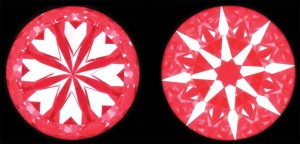Look at it this way

Brinkhaus theorizes that eroded margins in a highly competitive market have a lot to do with the number of branded and specialty cuts on the market.
According to Brinkhaus, some branded cuts were strategically developed to save more of the rough stone and so produce a larger carat-weight finished diamond, offering the manufacturer greater return on investment. And fancy cuts have been traditionally priced off the pear shape diamond pricing grid found in the Rapaport Diamond Report. However, new premium brands with only one outlet for purchase can be priced whatever that retailer choses.

Not everyone sees the value of branded cuts. Mel Moss, president of Regal Imports in Vancouver, thinks many are gimmicks, used mainly to distinguish the merchant or manufacturer from the competition. That alone, however, does not necessarily make it a better product. “The modern round brilliant was scientifically designed and cut to produce the most brilliance,” he explains. “Even when specialty cuts are patented, another cutter can tweak the faceting pattern somewhat and produce their own special diamond. This happened with the princess cut, which is widely sold. Other cutters made slight modifications and produced their own version of the princess and sold them under their own brand.”
Overall, De Witte believes that modified rounds remain a tougher sell. “I firmly believe the reasons customers ultimately pull the trigger on buying any particular stone is the story they get to tell their family and friends,” he says. “Top bragging rights are ‘I got the best deal’ and ‘I got the best diamond.'” However, he is quick to point out nothing sells itself. “Prevailing tastes and consequently, demand, have been largely sculpted by persistent advertising. I believe new designs are indeed the wave of the future.”
Diana Jarrett is an award-winning trade journalist and graduate gemmologist (GG). In addition to being a member of the National Association of Jewelry Appraisers (NAJA) and a registered master valuer, Jarrett is a popular conference and trade show lecturer. She writes a syndicated column called “The Story Behind the Stone” for the Southern Jewelry News and Mid-American Jewelry News and is also a writer for magazines such as Texas Jewelers, New York Mineralogical Club Bulletin, and the gem trade blog, Color-n-Ice.





